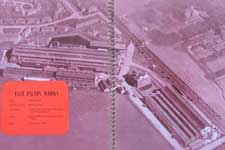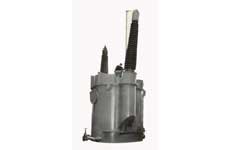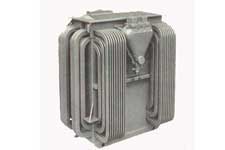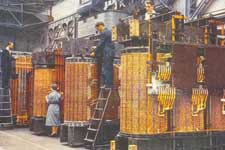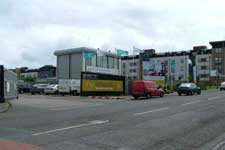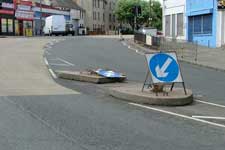Bruce Peebles
On this page
History
Bruce Peebles was a major employer in the Granton area between 1904, when the company moved to East Pilton, and 1999, when the works closed following a major fire. The works covered a large area east of Pilton Drive (opposite the present Ainslie Park Sports Centre) and north of the railway (now a walkway and cycle path) parallel with Ferry Road.
The company's founder, David Bruce Peebles, was born in Dundee in 1826 and worked in various engineering companies, including one that made gas meters. He left them in 1866 to set up his own business, also making gas meters, at Fountainbridge, Edinburgh. The business did well and had to move to larger premises, at Bonnington Road. The works were named 'Tay Works' reflecting Mr Bruce Peebles’ home town. As well as gas meters, they manufactured other equipment for gas lighting and devised improvements to existing products. By the 1890s they were also making gas engines, which were used for powering industrial machinery and used gas from the public supply as their fuel.
For centuries, lighting in buildings was by candles and later by lamps using liquid fuel such as whale oil and later paraffin. By the 1820s gas lighting was being used and gas works were built which converted coal into gas – for example at Baltic Street, Leith (1824). A system of pipes was laid under the streets to carry the gas to the buildings where it was to be used, and meters installed to measure the gas used so that customers could be correctly charged for it. The early gas lamps used flat nozzles (burners) which gave a fan-shaped flame. The gas was simply lit and the flame adjusted to burn yellow. Around 1890 a major improvement was made when Carl Auer von Welsbach introduced the incandescent mantle. This was a mesh impregnated with chemicals – 'rare earths' as they were called at the time – which glowed a brilliant white when heated. The gas flame could then be a properly adjusted efficient one, burning at an almost invisible blue inside the mantle.
The electric lamp as we know it today (the incandescent filament lamp) was devised almost simultaneously in the USA by Thomas Alva Edison and in the UK by Joseph Swan in 1878. (They agreed to co-operate under the trade name 'Ediswan'.) At the time, electric lighting was not widely used – it needed either a generator on the premises or the construction of power stations and the installation of electricity cables below the streets, whereas the gas pipes were already in place. It was probably not until the 1920s that there were more houses lit by electricity than by gas.
In 1898 Bruce Peebles started making electrical products, starting with dynamos, for generating electric current.
David Bruce Peebles died in 1899 at a time when his business was expanding. The firm was then run by his trustees, but in 1902 a limited company was set up to continue the business – Bruce Peebles & Co Ltd. The gas products were, from 1908, made by a separate company, Peebles & Co Ltd.
In the First World War (1914-1918) the company, like many others, made munitions but after the war went back to their normal activities.
The range of products increased. Transformer manufacture started in 1925 and rectifiers in 1929 – see products. Equipment made by Bruce Peebles was used throughout the UK and exported around the world, mainly to countries in the British Empire, such as New Zealand, South Africa and Canada. The 1920s and 1930s were years when electricity use was increasing rapidly, and there was a great need for equipment for public supplies and for projects such as railway electrification.
In the Second World War (1939-1945) the works again switched to producing items for war use, but this time electrical equipment such as searchlights, mobile transformers, minesweeping equipment for the navy and parts for the Mulberry Harbours. (These were temporary floating harbours made in sections in the UK and taken by sea to where they were needed.) King George VI and Queen Elizabeth (later the Queen Mother) visited the works in 1942 and again in 1944, showing that the company's contribution to the war effort was recognised.
After the war, normal business resumed. This was a time when hydro-electric power stations were being built, the national grid (which connected different areas with high voltage cables, mainly on pylons) was being greatly expanded, railway electrification was continuing and electricity use was still increasing.
In 1961, the company merged with Belmos but production continued at East Pilton, and a new transformer shop was built in 1963. In 1966 D T L Broxburn was formed, involving Bruce Peebles, Ferranti and English Electric. A further merger of the main company in 1969 with Reyrolle Parsons of Newcastle resulted in a name change to Parsons Peebles. D T L Broxburn became Parsons Peebles D T L Broxburn.
The gas side of the business, Peebles & Co, which had continued to operate from Tay Works, Leith, moved to Dunfermline in 1968 but closed down in 1973.
Further re-organisation of the main business took place. In 1977 the Reyrolle Parsons Group merged with the Clarke Chapman Mechanical Engineering Group to form Northern Engineering Industries plc and in 1984 the company was renamed N E I Peebles Ltd. Rationalisation followed, and the machine shop and fabrication shop closed in 1987. In 1989 N E I merged with Rolls-Royce and the company was renamed Rolls-Royce Peebles Electric in 1992. Rolls-Royce sold the business in 1998 and it became V A Tech Peebles.
On 12 April 1999 disaster struck when the main transformer shop was burned to the ground in a blaze which could be seen from many miles away. In the same year, the company was effectively divided, with the Peebles Electrical Machine Division (Motors & Generators) being sold to Pope (Australia) and relocated to Rosyth, on the north side of the River Forth and just upstream from the Forth Bridge, and the Transformer Division going to V A Tech.
The Pilton site was subsequently used for new houses, the streets being named after East Pilton Farm.
V A Tech constructed a new building towards the east end of Leith Docks, and the business moved out of the Granton area. Unfortunately, production there came to an end in 2004.
Products
Over the years, Bruce Peebles and their successors made a wide range of products. In 1964 these included:
- Generator and transmission transformers
- Rural, distribution and mining-type transformers
- Hydro-electric plant
- Synchronous condensers
- AC generators
- AC motors
- DC machines
- Control systems
In previous years, their products had included:
- Rotary converters
- Mercury arc rectifiers
The first steel cylinder rectifier to be supplied and installed in Great Britain was put into operation by Bruce Peebles in 1930 in the Dewar Place sub-station, for Edinburgh Corporation.
In the early years of electricity supply, the power stations, for example at Junction Place Leith (Leith Corporation), Dewar Place and Macdonald Road (Edinburgh Corporation) generated direct current (DC). They used dynamos usually driven by coal-fired steam engines. Later, from about the 1920s, alternating current (AC) was produced. This was more economical to transmit over long distances, the voltage could readily be changed with 'transformers', and it was somewhat safer. Portobello Power Station, opened by Edinburgh Corporation in 1923, was the first large AC generating station in the Edinburgh area. (The electricity industry was nationalised in 1947, this area being served by the South East Scotland Electricity Board (SESEB) and later by the South of Scotland Electricity Board (SSEB)).
However, there were many existing installations that used direct current, so there was a need to change one to the other. At first this was done with 'rotary converters' which were effectively an AC motor permanently coupled to a DC dynamo. By the 1920s technology had advanced and 'rectifiers' could be built that were large enough to deal with mains electricity. They had no moving parts and so were more efficient.
The electric trams in Edinburgh were built to use DC and did so right up to withdrawal in 1956. At the time DC motors were more easily controlled than AC. As a result Edinburgh Corporation had rotary converters and later rectifiers at various locations around the city such as Macdonald Road, Cowgate and Causewayside to convert the AC supply to the 550 V DC needed for the trams. This was taken to feed the overhead wires by heavy cables below the street, which fed the overhead at intervals.
If you want to know (a lot) more, click the links below...
What's there now?
The East Pilton site was vacated by V A Tech when they moved to Leith. Following demolition of the remains of the works and decontamination of the site, which had absorbed chemicals over the years of industrial use, houses were built by various developers. The development was named ‘The Strada’.
One feature connected with Bruce Peebles that survived for many years was the traffic islands at the junction of Pilton Drive and West Granton Road. Some of the largest transformers were shipped overseas from Granton Harbour, and were taken there from the works on low loaders. To allow them to negotiate the junction, the traffic islands were not permanent – they were precast concrete with steel lifting links cast into them so that they could be lifted aside with a crane. Originally they had electrically lit ‘keep left’ bollards with a plug and socket arrangement on the street surface below. In recent years one of the islands went missing, and they all have now been removed.
